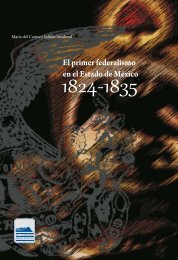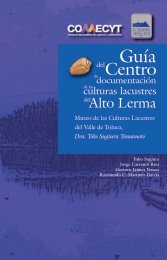Create successful ePaper yourself
Turn your PDF publications into a flip-book with our unique Google optimized e-Paper software.
KORPUS <strong>21</strong>, VOL. 4, NÚM. <strong>10</strong>, 2024, 113-126<br />
Much of this story was being told in historiography<br />
as state-directed prescription, rather than<br />
lived individual experience. Still the material<br />
helped me interpret Pepe’s story and that of his<br />
generation. From the late nineteenth century,<br />
so the story went, Mexican psychologists, employers,<br />
military officers, sociologists, novelists,<br />
hygienists, doctors, social workers, educators,<br />
Catholic activists, journalists, and public intellectuals<br />
expressed concern about what they viewed<br />
as lower class masculinity prone to social, political<br />
and familial violence, irresponsibility, alcoholism,<br />
and sexually transmitted disease”. 6 If in<br />
the Porfiriato criminologists viewed the “condition”<br />
as a product of biological degeneracy and<br />
sought to isolate the poor, the reformers of the<br />
Revolution sought national integration, education,<br />
and health.<br />
From the mid 1930s when a good part of the<br />
world entered a period of devastating politics<br />
and war, Mexico began a prolonged period of<br />
demilitarization, social peace, and economic<br />
growth. In 1946, the ruling PRI abolished its military<br />
sector and the lottery replaced obligatory<br />
conscription. Overt violent social conflict decreased.<br />
Such conflict had positioned organized<br />
workers for material improvement. After 1940s,<br />
possibilities for legal, protected employment<br />
increased. Conditions of daily life improved for<br />
many in Mexico City if less than dramatically because<br />
in retrospect consumerism was in its infancy:<br />
detergents, clothing, hair products, cosmetics,<br />
gas, running water, a stove, a radio. TVs,<br />
cars, and washing machines came in the 1960s.<br />
These broad transitions are inadequately examined<br />
by historians who work in silos that fragment<br />
experience (as one discusses economic<br />
growth, another consumption, another adop-<br />
6 The historiography is dense. Key primacy sources are El<br />
genésis del crimen en México (Guerrero, 1901); Los criminales<br />
en México (Roumagnac, 1908); El perfil del hombre y la<br />
cultura en México (Ramos, 1934). Key secondary sources are<br />
City of Suspects: Crime in Mexico City, 1900-1931 (Piccato,<br />
2001), “The Science of Redemption: Syphilis, Sexual Promiscuity,<br />
and Reformism in Revolutionary Mexico” (Bliss,1999);<br />
“For the Health of the Nation: Gender and the Cultural Politics<br />
of Social Hygiene in Revolutionary Mexico” (Bliss, 2006);<br />
Criminal and Citizen in Modern Mexico,(Buffington, 2000),<br />
A Sentimental Education for the Working Man: The Mexico<br />
City (Buffington, 2015); William French, A Peaceful and Working<br />
People (French, 1996); Myths of Demilitarization in Post<br />
Revolutionary Mexico (Rath, 2013), “Responsible Mothers and<br />
Normal Children: Eugenics, Nationalism, and Welfare in Post<br />
Revolutionary Mexico” (Stern, 1999); “The Mexican Revolution<br />
and the Modernization of Patriarchy in the Countryside,<br />
1930-1940” (Vaughan, 2000).<br />
tion, etc.) The biographer can see how discrete<br />
processes interpenetrate.<br />
I reexamined familiar texts as pointed critiques<br />
of contemporary Mexican masculinity in<br />
the 1950s and early 1960s. To my knowledge,<br />
these had not been linked to the above narrative<br />
of state and market driven domestication. Oscar<br />
Lewis (1964) articulated new trends in psychology<br />
and personality development in his focus on<br />
Jesús Sánchez’ emotional abuse of his children:<br />
the father brought home money, but his positive<br />
emotions were brutally shut down (Lewis,<br />
2011). Octavio Paz in his Laberinto de la Soledad<br />
(1950) psychologized the Mexican man (especially<br />
of the popular classes) as enclosed in deep<br />
insecurity, prone to uncontrollable, drunken<br />
eruptions of violence, and not “mature” enough<br />
to embrace a universal humanism. 7 Psychologist<br />
Erich Fromm, writing from Cuernavaca, in his Art<br />
of Loving (1956) called for a more emotionally<br />
open and mature masculinity (Fromm, 1956).<br />
Pepe Zuñiga concurred: he adored his father, but<br />
for all Señor Zuniga shared about the movies, he<br />
was cold, aloof, and abusive of his wife. Pepe<br />
longed for a father like Shane, the reformed gunfighter<br />
who offers tenderness and advice to the<br />
adoring boy Joey Starett in the 1953 film classic.<br />
Pepe knew nothing of Lewis, Paz, or Fromm but<br />
he too was part of an ongoing social, moral and<br />
political project.<br />
In effect, Pepe joined youth’s seizure of the<br />
project on their own terms at the end of the<br />
1950s. Fathers lost prestige and authority (Zolov,<br />
1999, 115). Rock n roll bands and the Beatles<br />
knocked out Pérez Prado (exiled), Agustín Lara<br />
(dead in 1970), María Luisa Landín (stopped<br />
recording in 1967). Young novelists like José<br />
Agustin searched for self and love. Young readers<br />
devoured it. Students packed the theater<br />
to watch young actors trained by Hector Azar,<br />
head of the Teatro Universitario of the UNAM,<br />
enact Olímpica. The play explored the anguish<br />
of adolescence in a poor tenement in central<br />
Mexico City: young Eddie, handsome, restless,<br />
disoriented, and full of dreams with nowhere to<br />
go, and Casandra (Casi) frozen in her Catholic<br />
soul fearful she would fall into sin as she passed<br />
into womanhood. The actors, wrote critic Armando<br />
de Maria y Campos, directed with energy<br />
and tenderness by the very young Azar<br />
7 See Labyrinth of Solitude (Paz, 1961). Spanish version, 1950.<br />
1<strong>21</strong>



![bicentenario_1[V2]](https://img.yumpu.com/68677971/1/167x260/bicentenario-1v2.jpg?quality=85)



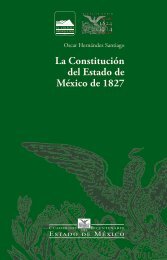

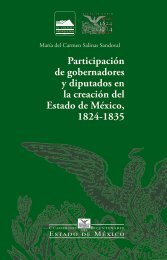
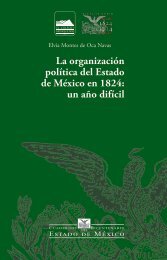

![El_primer_federalismoEM[final]_compressed (2)](https://img.yumpu.com/68483279/1/178x260/el-primer-federalismoemfinal-compressed-2.jpg?quality=85)
